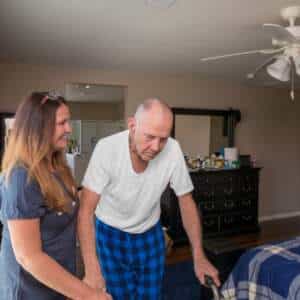Amyotrophic lateral sclerosis (ALS) is a devastating neurological disease that affects individuals of all ages no matter their background. It can cause significant physical, emotional, and financial strain for those who suffer from it. Many people don’t know about this condition despite its prevalence.
physical, emotional, and financial strain for those who suffer from it. Many people don’t know about this condition despite its prevalence.
For patients with ALS, understanding this illness is key to finding better treatments and improving their quality of life. There’s no cure for ALS available y
et, but researchers continue to work tirelessly to develop new strategies that could help alleviate symptoms and slow down the progression of the disease.
In this article, we’ll examine ALS in-depth: what causes it, how it develops over time, current treatment options available, and lifestyle changes you can make to cope with it.
Understanding Als
ALS, also called Lou Gehrig’s Disease, is a progressive motor neuron disease in the central and peripheral nervous system.
The term “amyotrophic” is derived from Greek, where “a” means no, “myo” relates to muscle, and “trophic” translates to nourishment. Therefore, amyotrophic signifies a lack of muscle nourishment, which leads to muscle atrophy or degeneration.
The word “lateral” specifies the locations within the spinal cord where the nerve cells that govern muscle movement are situated. As these areas deteriorate, they undergo scarring or hardening, known as “sclerosis.”
Motor neurons extend from the brain to the spinal cord and from there to muscles across the body. In ALS, these motor neurons progressively degenerate and ultimately fail.
This deterioration results in the brain’s loss of the ability to initiate and manage muscle movement. As the disease progresses, it increasingly impairs voluntary muscle activities, affecting speaking, eating, moving, and breathing abilities.
The specific motor nerves impacted in ALS are those that regulate voluntary muscle movements, such as reaching for a smartphone or stepping off a curb, which involve the muscles in the arms and legs.
Who Gets Als – Different Types of ALS
Like a puzzle with many missing pieces, the mystery of who gets ALS remains unsolved. The ALS Association estimates that as many as 30,000 people are living with ALS in the United States at any given time. However, anyone can develop ALS at any age, and it is not necessarily inherited.
There are 3 types of ALS: sporadic, which accounts for 90-95% of ALS cases; familial ALS, which shows a genetic link and accounts for 5-10% of cases; and the Mariana Island variety, which is only found in a specific population in the Western Pacific Islands.
The most common form of ALS affects mostly adults over 40 years old, but adolescents can be affected too. The most common age for diagnosis is 55 years.
It impacts men twice as often as women, and some ethnic groups show higher rates of incidence than others, according to research from the ALS Association. Research suggests that genetics may play a role in some forms of ALS since the condition appears to run in families; however, much remains unknown about why certain individuals get this devastating illness while others do not. Approximately 5,000 new cases of ALS are reported every year.
Etiology: What Causes ALS
The exact cause of ALS remains unknown; however, researchers have identified various factors that may play a role in its development. Environmental exposures such as toxins and infectious agents are thought to be potential triggers. Genetic mutations can also increase one’s risk of developing it.
Some of the features of ALS are similar to those of Alzheimer’s disease. The tangled neural fibers and deposits of abnormal proteins on groups of cells. However, ALS does not affect memory, only motor skills.
Other contributing factors to ALS may include genetic susceptibility to damage from free radicals, autoimmune disease, and mitochondrial dysfunction. Another predictive indicator of ALS is the absence of neurotrophic factors or chemicals that support the health of the nerve cells.
Signs & Symptoms Of Als

Als is a progressive disease. Symptoms worsen over time, including weak muscles, twitching, cramping, stiffness, and difficulty speaking clearly or swallowing food/beverages due to weakened throat muscles.
As the progression of the neurodegenerative disease continues, it will create breathing difficulties caused by weakened lungs. People may experience shortness of breath while walking at normal paces, which also worsens over time. ALS does not affect intellectual capacity at all.
Due to its type of motor neuron disease nature, ALS affects all voluntary movements within our bodies, including talking, eating, and even blinking. For some people who have ALS, these involuntary movements are replaced by an ever-growing list of medical equipment such as respirators and wheelchairs used to maintain quality of life as much as possible.
Diagnosing ALS
Diagnosis of amyotrophic lateral sclerosis (ALS) is a key factor in understanding its progression. ALS research has helped medical professionals develop methods and tests for diagnosing ALS. Knowing what symptoms start when, how they progress, and which ones are most indicative of ALS usually helps doctors determine whether someone has ALS.
The process for diagnosing ALS typically begins when an individual notices changes in their body or experiences muscle weakness that persists over time. After this initial step, the patient will receive further testing from a multidisciplinary ALS clinic to help them get diagnosed and rule out other potential causes. This usually includes blood work, electromyography (EMG) tests, nerve conduction studies (NCS), imaging scans such as MRI or CT scans, lumbar puncture spinal taps, and more, depending on the case.
In summary, diagnosing ALS involves specific steps, including reviewing symptoms and undergoing various clinical tests under specialized care; once diagnosed, several treatments are available to manage symptoms while attempting to slow down its progression.
Treatment for ALS
It’s time to turn our attention to the treatment of ALS. With a heavy heart, it must be stated that there is currently no cure for ALS,, and its prognosis remains poor. That said, with the help of medications, physical therapy, and various other treatments, patients can often improve their quality of life by managing symptoms such as muscle weakness and by helping them keep functioning at the highest possible level.
Treatment may include regular visits to a physician, occupational therapist, speech-language pathologist, and/or respiratory therapist; participating in educational programs on managing their illness; using assistive devices like wheelchairs or walkers; taking prescribed medications; undergoing strength training exercises; and more. Heat and whirlpools are beneficial for muscle spasms.
Of course, people who have ALS also require emotional support—both for those affected directly and those close to them. Support groups can provide invaluable assistance when facing this devastating disease. In these settings, people connect emotionally with others who are going through similar experiences while sharing information about helpful resources.
Additionally, many organizations are specifically dedicated to providing support services and financial aid for families with ALS worldwide. A range of services, including counseling, respite care, and home care, are available to help manage symptoms associated with the disease
No matter what approach you take towards managing your own ALS symptoms or supporting someone else fighting this difficult battle against progressive paralysis—whether it’s seeking out medical advice from experts or gathering around friends and family members for mutual understanding—it’s important that we never forget hope still exists even during times of adversity.
Prognosis
The prognosis of ALS is usually poor, with the majority of people diagnosed surviving three to five years after symptoms begin. People who have been diagnosed with ALS live an average of two to five years, but this can vary from person to person, depending on their general health and access to medical care. Most ALS patients die of pneumonia or extreme weight loss, and 90% of people with ALS die within 6 years, but some people with ALS live for decades. Stephen Hawking lived over 50 years with ALS!
Is Massage Safe And Helpful
Massage is like a warm hug for the body of individuals living with the nervous system disease. It helps to ease pain, relax tense muscles, and bring comfort during a difficult time. For people affected by Amyotrophic Lateral Sclerosis, massage can be an important part of their treatment plan.
relax tense muscles, and bring comfort during a difficult time. For people affected by Amyotrophic Lateral Sclerosis, massage can be an important part of their treatment plan.
It’s essential that individuals with ALS consult with their healthcare team before getting a massage in order to ensure it will be safe and beneficial. Massage therapists should also learn more about ALS so they know how to tailor treatments accordingly. Depending on which stage of the disease someone is in, certain pressure points or styles may not be suitable.
When done correctly, massage therapy has many positive benefits for patients diagnosed with ALS and its common symptoms, including improved posture, increased range of motion, and loosening of tight muscles. Additionally, healing touch can provide emotional support and help reduce stress levels when faced with such a challenging illness.
People who receive regular massages often feel invigorated and relaxed afterward, which is something that those with this debilitating condition need.
Frequently Asked Questions
What Is The Life Expectancy Of Someone Living With Als?
The average survival rate after diagnosis is three years, but some may survive five years or more. Unfortunately, there is no way of knowing how long a person will live with this condition–it all depends on the individual and their response to treatment.
Many factors influence an individual’s longevity when they have ALS. Age at the time of diagnosis, disease progression rate, access to treatment options, general health prior to the development of symptoms, and the type of mutations in their genes all play a role in determining life expectancy. Additionally, certain lifestyle choices, such as diet and exercise, can impact how quickly the body deteriorates due to the degenerative nature of ALS.
Are There Any Lifestyle Changes That Can Help Manage Als?
 A doctor or specialist can advise on how best to adjust daily activities to accommodate changing needs caused by the disease—such as using adaptive equipment like wheelchairs or walkers if needed—and suggest other strategies for maintaining independence where possible. It’s essential to stay connected with healthcare professionals who understand your specific ALS-related challenges to ensure you have proper support and resources available when needed.
A doctor or specialist can advise on how best to adjust daily activities to accommodate changing needs caused by the disease—such as using adaptive equipment like wheelchairs or walkers if needed—and suggest other strategies for maintaining independence where possible. It’s essential to stay connected with healthcare professionals who understand your specific ALS-related challenges to ensure you have proper support and resources available when needed.
Are There Any ALS Clinical Trials?
Clinical trials are important in finding new treatments and understanding the various causes and impacts of conditions like ALS. It’s essential to consider all available avenues to understand better how to treat this condition.
Clinical trials test potential therapies in a controlled environment with strict protocols that help ensure safety and efficacy. Patients may also have access to new medications or techniques before they’re available on the market.
By participating in these studies, individuals can contribute valuable information that helps researchers gain further insight into ALS. Furthermore, patients may receive care from some of the world’s leading experts while participating in these studies – something that cannot be found elsewhere.
It’s important to remember that not everyone will qualify for a trial; however, those who do benefit greatly from being able to participate in cutting-edge research and discover potentially life-saving breakthroughs. It’s also worth noting that patient confidentiality is always maintained throughout the process. To learn more about current clinical trials related to ALS, visit your doctor or contact a relevant organization such as The ALS Association or ALSA Caregiver Support Network. With their help, you could uncover opportunities you didn’t even know existed!
Are There Any Support Groups For People With Amyotrophic Lateral Sclerosis?
Individuals facing this difficult journey often look to others for help and guidance. Fortunately, there are several organizations dedicated to connecting individuals affected by ALS and providing them with the necessary resources and support they need during their struggles.
Living with ALS can be incredibly challenging – both physically and mentally – but having access to a supportive community of peers makes it easier. Support groups allow members to share experiences, advice, tips, and empathy while learning from one another in meaningful ways. From physical therapy techniques to emotional coping strategies, these connections can make all the difference when managing symptoms on a daily basis.
Whether online or in person, there are plenty of opportunities to find communities of like-minded individuals dealing with similar situations. These networks offer hope, solidarity, and practical advice, which can prove invaluable when tackling obstacles related to living with ALS. Taking advantage of these available resources may just make life’s challenges more manageable.
Is There Any Genetic Testing Available To Determine If I Am At Risk For Developing Als?
Are you concerned about your risk of getting ALS? Genetic testing may be a good way to answer some questions. There are many types of genetic tests available, and each can provide insight into the chances that you have or could develop ALS.
It’s important to understand what is being tested, how accurate the results are, and who should get tested. By understanding these factors, you can make an informed decision as to whether or not this type of testing is right for you.
Genetic testing has advanced greatly in recent years, providing more information than ever before. Knowing if you are at risk for ALS can help with early diagnosis and treatment plans. Consider speaking with your doctor about your options and potential risks so that you can determine if getting tested is best for you.
Conclusion
ALS can be a challenging and unpredictable journey. Remember that life expectancy for someone with ALS varies depending on the individual. Although there is no cure for this devastating illness, lifestyle changes such as proper nutrition, exercise, and stress management with massage can help manage symptoms and improve quality of life.
Clinical trials may provide access to new treatments and support groups where people facing similar struggles can come together to share their experiences. Finally, if you are concerned about your risk of developing ALS, genetic testing is an option worth exploring – it could be a lifesaver!
If you want to schedule a massage with us, click here or call 614-604-6358!





